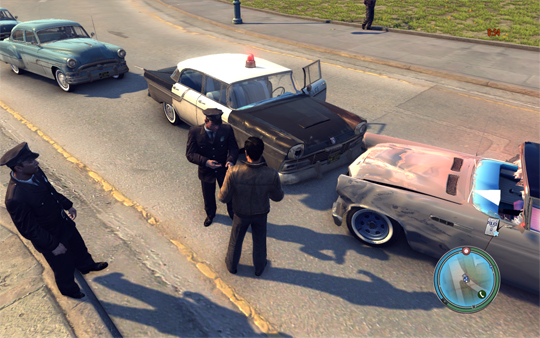Games that defy the expectations of a genre shouldn’t be applauded just because they contradict preconceived notions, but they should be applauded if they do it well. Mafia 2, 2K Czech’s long-awaited sequel to the cinematic, story-driven, PS2 mob drama, Mafia, rethinks open-world games, likely to the frustration of gamers looking for Grand Theft Auto 4 meets The Godfather.
Simply put, everything in Mafia II is about the story it tells. While this poses an obvious risk as an affront to the freedom and player-driven creativity of the open-world genre, I believe the return more than compensates for the sacrifices. It pushes the envelope of how developers can think about atmosphere and immersion, served up with a heaping helping of booze, babes, wise guys, and of course calzones.
Suffice it to say that story is Don in Mafia II, from the few segments that take place outside the city, Empire Bay, to the very apparent lack of incentive to do anything else besides story missions throughout. Players jump in the shoes of Vito Scaletta, motivated by love for his family and his best friend Joe Barbaro, his fluctuating moral convictions, and every gangster’s dream of being "somebody" in America. Similarities and direct nods to famous Mafioso media entries abound, though more closely align with "GoodFellas" than anything else.

I’ll sidestep any specific details in favor of preserving the freshness of the narrative, but it’s a damn good time. The characters are well acted and believable and the ebb and flow of conflict, resolution, surprise, and climax are artfully weaved into an emotionally charged and comfortably familiar struggle. My one grievance with Mafia II‘s story, and it’s a big one, is the ending, which will likely garner a dive bar full of contradicting feelings. My particular stance is that while the length of the game feels appropriate, the finale hardly offers the resolution you are yearning for throughout the entire game, and is basically just a big flashing neon sign that shamelessly shouts, "Buy Mafia 3."
In terms of mechanics, Mafia II plays well but not perfectly. The cover system is easy enough to use and get used to, but the reliance on cover both for the player and for enemies does dissolve almost every armed conflict into a stop-and-pop shootout which gets a bit old. If you’re looking for a more run-and-gun experience, you can always set the difficulty to Easy, but I would highly recommend playing this game on the hardest difficulty because it’s a pretty easy ride to begin with. Playing on Hard can be frustratingly difficult in later missions, but creative solutions are required to surmount the increase in challenge (like stopping a garage door by jamming a car beneath it), and therefore add to the feel of realism and freshness.
Do note that this game will require a lot of driving. A lot. As an errand boy for various enforcers and capos, Vito will spend much of his time going across the 10-square-mile city for something as simple as a conversation, but the driving is legitimately fun if you break the law. By that I mean if you speed and run lights, which will attract the attention of the fairly easily duped police force and initiate impromptu car chase sequences. And the period-authentic music (accurate even to the year being played, spanning from 1945-1951) not only establishes time and place but gives the player something to do on the long drive from cat house A to abandoned warehouse B.

At this point, it’s hopefully evident that Mafia II does not conduct itself the way most AAA open-world games do these days. You can’t choose which story mission you want to do from a set of four or five, there aren’t really any side missions aside from stealing cars or robbing stores, but the benefit to either is so marginal it’s not really worth pursuing. Every bit of gameplay is directed at one fairly linear story. Players will easily acknowledge this fact upon spending as little as an hour in-game, but the question is can you really call this an open-world game when it’s really more of a story-driven, third-person shooter, and does that even matter?
I’d argue that yes, Mafia II is still an open-world title, and no, it doesn’t matter. The city of Empire Bay is huge and chock full of highly detailed indoor and outdoor environments, most of which are entirely unique and never repeated. But rather than use this world for the service of extended gameplay through side missions, exploration, and the like, it is all there to create a believable, breathable story. Sure, it’s a little disappointing at the end of the game when you realize you’ve barely even scratched the surface of this incredibly detailed world, but the purpose for which is was created is deftly fulfilled. It’s a new way of thinking about "open-world" in the sense that, if approached correctly, expanding scope can be just as much an ally of detailed, immersive atmosphere as limiting scope can be. Developers, take note.
Mafia II is certainly an enigma among mob drama games, eliciting both an intense satisfaction with story and place while accruing simultaneous disappointment at the limitation of its focus. While the upcoming DLC packs promise to open up Empire Bay to further exploration, the game in itself feels too narrow to be perfect, but perfect in its narrowness. It’s an exciting, gritty, intense, and dramatic experience not to be missed by lovers of mafia movies, period pieces in gaming, and some of the best storytelling of this generation.


















